(i) The Dawn of a New Age
The Broken Sword Glyph – an intricate web of interconnection offering a tantalising insight into the evolution of humankind.
Invention or discovery? Looking back over the course of its evolution, the systematic way it built up – starting with the Swastika synchronicity and proceeding through a series of sequential steps: the landmarks in Ilkley, the events in Dubai, the three November 22 dates – there is the impression of something steadily taking shape from the mist, a story bleeding through from another realm. Order out of chaos. An emergent phenomenon.
Emergence. I am reminded of the Hopi worldview and what emergence means for them: passage from one world into the next. In the Hopi creation myths, the emergence into and migrations through this present world trace out the symbol of the Swastika.
Patterns that connect.
Realities nestled within each other like Russian dolls. Hidden secrets surfacing, a map of existence unfurling before us. Nebulous truths taking on more definition as the World Mind closes upon an idea.
It is December 29, 2007 and having constructed the Broken Sword Glyph, my mind is reeling from the connections. I am a little wired, energised by the improbability of it all.
Then, as if to underline the power and magic of the symbolism, there occurs one of the most compelling episodes of synchronicity I have yet to experience. It is the morning after the glyph’s construction and I have been editing its description. At its heart lies the symbolic interpretation of three historical figures – Aldous Huxley, CS Lewis and John F Kennedy – who each represent a different aspect of a complete whole, corresponding respectively to the qualities of Thought, Feeling and Will.
Putting the work aside, I return to my reading matter, The Flaming Door, to reach, an hour or so later, the penultimate chapter: The Dawn of a New Age. To my amazement I discover the chapter devoted to an identical premise to the one I have just been writing about: the symbolic interpretation of three historical figures each of whom represents a different aspect of a complete whole, and who correspond respectively to the qualities of Thought, Feeling and Will.
The links between what I am now reading what I have just this very morning been writing about are extraordinary. The new information dovetails incredibly into the story of the Broken Sword Glyph, reinforcing its interpretation, providing a fascinating context and offering fresh insights. It is with a growing sense of wonder that I make my way through the pages of Merry’s book.
The three men in The Dawn of a New Age are John of Salisbury, Thomas Becket and Henry II.

The men play out their symbolic roles during the twelfth century, a time when the emerging group soul of the British Isles is being shaped. A nation has a soul just as an individual has a soul, and in both cases the same three aspects go to make it up.

Merry is describing a period during which solar, rational forces are on the ascent, with the lunar/earthly forces retreating to the background. At this time, Christianity is being established as the dominant religion throughout Europe, with a dimming of the pagan, nature-based religions of old.
The author explains how during the twelfth century, a struggle is taking place that will shape the world in which we live: a struggle to unite the inner, mystical heart of Christianity (which at this time still carries the wisdom of the old ways) with the outer, materialistic empire-building forces at play in the world.
[There was a] search for a way of uniting esoteric Christianity, still imbued with the best elements of the old Mysteries, with that part of the spiritual life of man which is destined to be the builder of external civilizations.Eleanor Merry, The Flaming Door
The time, however, is not right.
But the twelfth century demanded an intellectual development in which this spiritual union was not possible.Ibid.
In the evolving civilization, Thought takes precedent over Feeling.
The chapter then turns its focus to England, where these forces are being played out on a national scale.
If we look at the England of that time we see a remarkable development going on, the struggle for the accomplishment of the real birth of the English Folk-Soul, incarnating into, and striving to bring into harmony, all the elements of its composition.Ibid.
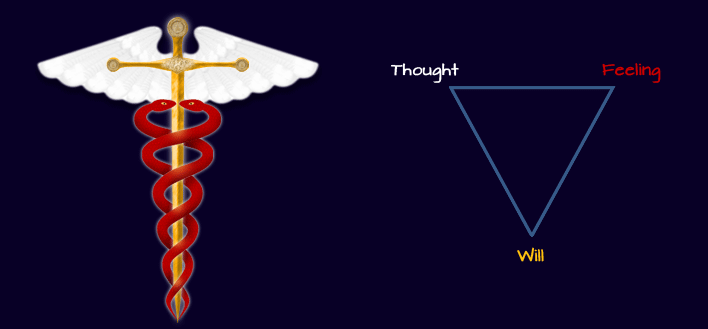
The problem is that the Britain of the twelfth century is not integrated. The true “Britons” – the Celtic races that inhabited the land for centuries – have retreated to the margins, leaving the “English” – the Anglo-Saxons and their conquerors the Normans – to stamp their mark upon the emerging country.
We said just now that places were important. It seemed as though the actual ‘earth’ of Western Britain were still so alive under the cloud that had fallen over its ancient sanctuaries, that it had a repellant power – built around itself a spiritual wall, against which, in Ireland and in Wales, no arrogant conqueror could prevail.Ibid.
In other words, the developing rational, solar nation is cut off from the deeper wisdom of the mysteries – its mythic, sacred heart.
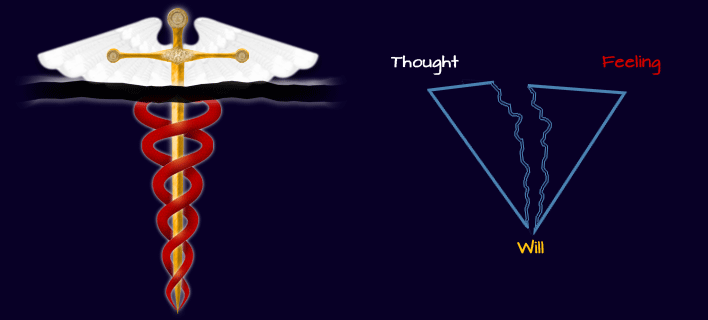
The Celtic races hold onto their old sense of mystical and earth-based spirituality.
The ‘English’ and the ‘Britons’, the latter with their predominating Celtic blood, were not yet welded together. The former were advancing towards a real self-conscious Ego-hood; the latter were still a people into whom their ‘earth’ breathed the old indeterminate dreamlike qualities, a heritage for which they fought like those who are fired by a blood-feud, with passion and conviction and incomparable heroism.Ibid.
Having looked at the bigger picture, Merry then focuses in on the three historical contemporaries.
There were three human beings in the twelfth century who seemed to have been focal points in the consummation of the immediate destiny of England, spiritually and externally, and so bringing about something like the actual birth of the English folk-soul…
These three human beings were bound together in a strange knot of personal, and world, destiny. They seemed like separate embodiments of the three qualities of the soul of a people.Ibid.
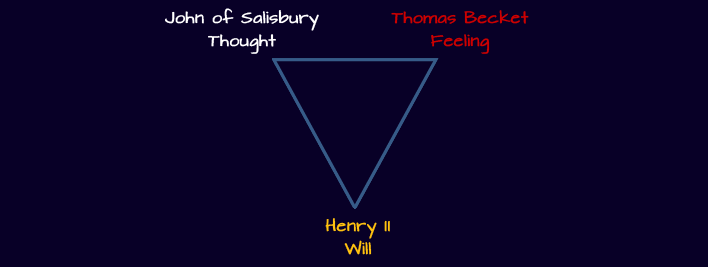
But the time isn’t right. The murder of Thomas Becket in 1170 marks the suppression of Feeling and the emergence of a nation dominated by Thought and Will.
It seems like a tragedy, but it is necessary for the inner mysteries to go underground lest they be corrupted by the materialistic forces at play in the world.
The Dawn of a New Age offers a fascinating backstory to the current state of the world. Many authors speak of the suppression of the old nature-based religions by the encroaching tide of Christianity; fewer present the process as a necessary stage in human evolution.
One paragraph in particular captures my imagination for its striking relevance to the Broken Sword Glyph. The paragraph begins by mentioning chasms, evoking the imagery of the Abyss upon which the fateful November 1963 date is placed. The Broken Sword Glyph hints at a deeper meaning to this catastrophic day; Merry also alludes to an underlying process behind the surface vicissitudes of life. She then goes on to describe the exact thing the November 1963 date represents – a focal point where the three threads of Thought, Feeling and Will are gathered together.
No matter what apparent chasms are rent in the sequence of external historical events, the spiritual evolution of man passes in reality quite harmoniously from stage to stage; and at every point it is possible to trace, in single individuals, real foci where all the threads are visibly gathered together, representatively, in qualities either of will, or thought, or of feeling.Ibid.
(THOUGHT, FEELING AND WILL IN MODERN TIMES)
Just as the above excerpt could have been written specifically for the Broken Sword Glyph, so the way in which Merry describes her three twelfth century figureheads can be transposed onto the Glyph’s three twentieth century men:
These three human beings were bound together in a strange knot of personal, and world, destiny.
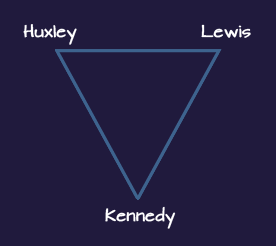
They seemed like separate embodiments of the three qualities of the soul of a people.
As Merry suggests, there are many instances where the Thought-Feeling-Will triad can be found. As well as in history it crops up in popular culture, one of the most striking examples occurring in The Wizard of Oz.
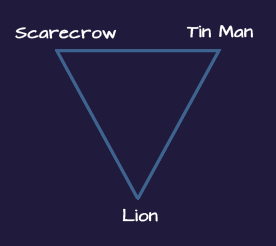
Brain
Thought
Heart
Feeling
Courage
Will

 TOP
TOP NEXT
NEXT